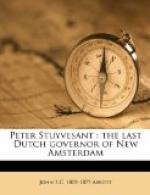“Thus the Plymouth colonists on the Connecticut, themselves intruders within the territory of New Netherland, soon began to quarrel with their Massachusetts brethren for trespassing upon their usurped domain.”
In November of this year, Governor Winthrop dispatched a bark of twenty tons from Boston, with about twenty armed men, to take possession of the mouth of the Connecticut. It will be remembered that the Dutch had purchased this land of the Indians three years before, and, in token of their possession, had affixed the arms of the States-General to a tree. The English contemptuously tore down these arms, “and engraved a ridiculous face in their place.”
The Dutch had called this region, Kievit’s Hook. The English named it Saybrook, in honor of lords Say and Brook, who were regarded as the leading English proprietors. Early the next year the Massachusetts people established a colony at Agawam, now Springfield. Thus, step by step, the English encroached upon the Dutch, until nearly the whole valley of the Connecticut was wrested from them.
About this time Van Twiller issued a grant of sixty-two acres of land, a little northwest of fort Amsterdam, to Roelof Jansen. This was the original conveyance of the now almost priceless estate, held by the corporation of Trinity Church. The directors, in Holland, encouraged emigration by all the means in their power. Free passage was offered to farmers and their families. They were also promised the lease of a farm, fit for the plough, for six years, with a dwelling house, a barn, four horses and four cows. They were to pay a rent for these six years, of forty dollars a year, and eighty pounds of butter.
At the expiration of the six years the tenants were to restore the number of cattle they had received, retaining the increase. They were also assisted with clothing, provisions, etc., on credit, at an advance of fifty per cent. But notwithstanding the rapid increase of the Dutch settlements, thus secured, the English settlements were increasing with still greater rapidity. Not satisfied with their encroachments on the Connecticut, the English looked wistfully upon the fertile lands extending between that stream and the Hudson.
The region about New Haven, which, from the East and West rocks, was called the Red Rocks, attracted especial attention. Some men from Boston, who had visited it, greatly extolled the beauty and fertility of the region, declaring it to be far superior to Massachusetts Bay. “The Dutch will seize it,” they wrote, “if we do not. And it is too good for any but friends.”
Just then an English non-conformist clergyman, John Davenport, and two merchants from London, men of property and high religious worth, arrived at Boston. They sailed to the Red Rocks, purchased a large territory of the Indians, and regardless of the Dutch title, under the shadow of a great oak, laid the foundations of New Haven. The colony was very prosperous, and, in one year’s time, numbered over one hundred souls.




